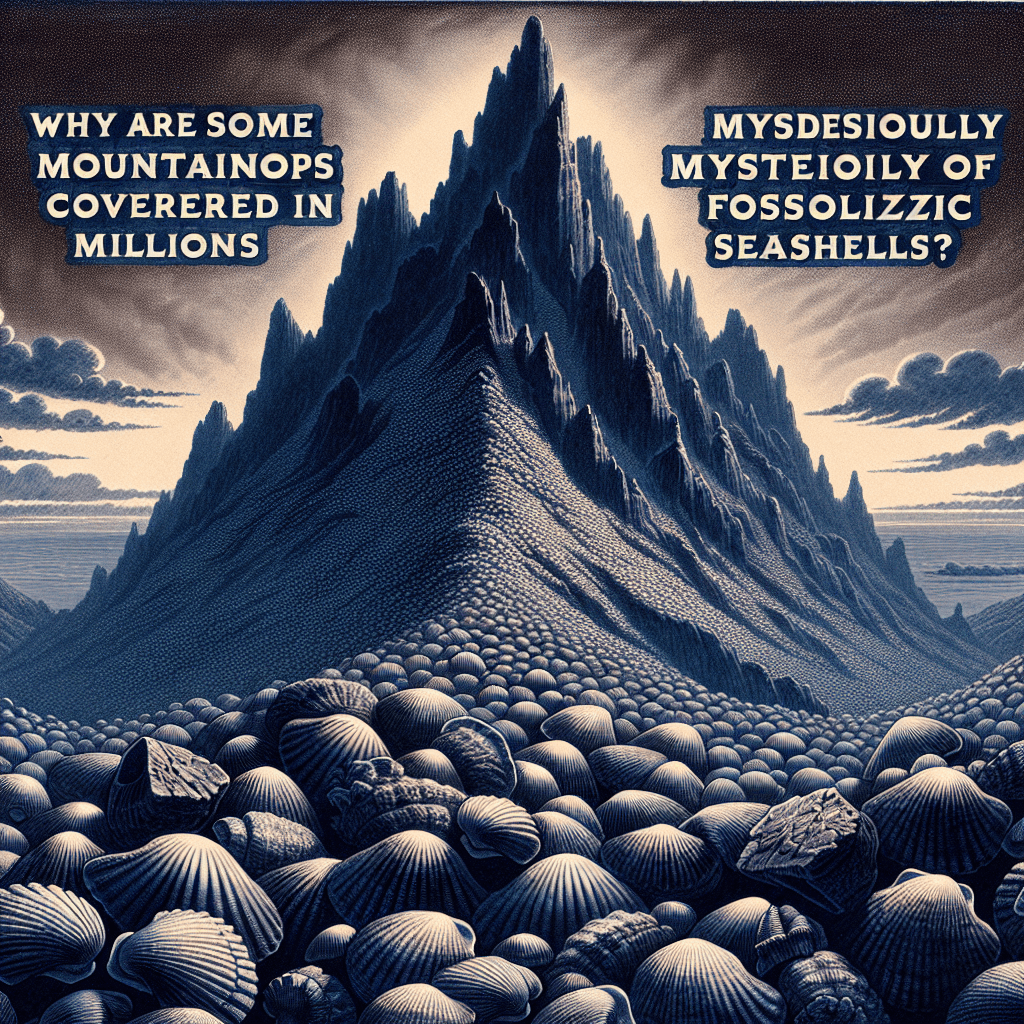Why are some mountaintops mysteriously covered in millions of fossilized seashells
Long before any climber, ancient sea creatures reached the world's highest summits. Uncover the incredible story of how the ocean floor was thrust thousands of feet into the sky, leaving millions of fossils in its wake.


Too Long; Didn't Read
TLDR: The seashells were never carried up the mountains. The mountains are ancient seabeds that were pushed upwards over millions of years by colliding tectonic plates, bringing the fossil-rich ocean floor with them.
Blog Post Title: From Seabed to Summit: Why Are Some Mountaintops Mysteriously Covered in Millions of Fossilized Seashells?
Imagine trekking high in the Himalayas, thousands of feet above sea level, surrounded by snow-capped peaks. As you examine a rock face, you spot something impossible: the perfect, spiral impression of a seashell. This isn't a fluke. The world's highest mountain ranges, from the Andes to the Alps, are filled with the fossilized remains of ancient marine creatures. This baffling discovery, which puzzled naturalists for centuries, isn't a mystery but a spectacular clue to our planet's dramatic and dynamic history. This post will unravel the geological story of how millions of seashells ended up on the roof of the world, transforming ancient seabeds into today's towering mountains.
An Ocean Before Mountains: The Story of Plate Tectonics
The first key to understanding this phenomenon is realizing that mountains are not permanent fixtures of our planet. Where today's great peaks stand, vast and ancient oceans once existed. For example, the Tethys Sea, a massive tropical ocean, once separated the ancient continents of Laurasia and Gondwana.
For over 100 million years, this ocean was teeming with life. As marine creatures like ammonites, clams, and plankton died, their shells and skeletons drifted down to the ocean floor. Over eons, these remains mixed with silt and sand, accumulating in thick layers. The immense pressure from the water above and the layers of sediment compacted this organic material, hardening it into sedimentary rocks like limestone and shale. This process perfectly preserved the remains of the sea life, trapping them as fossils within the newly formed rock.
The Force of Uplift: How Seabeds Reach the Sky
The fossils were locked in stone at the bottom of the sea, but how did they get to the summit? The answer lies in the colossal power of plate tectonics. The Earth's crust is not a single, solid shell but is broken into massive plates that are constantly, slowly moving.
The process that builds mountains is called orogeny, which often occurs when two continental plates collide. The most famous example is the formation of the Himalayas. About 50 million years ago, the Indian Plate, which had broken away from Gondwana, began crashing into the Eurasian Plate. The collision was not a single event but a slow, continuous crunch that continues to this day.
As these two landmasses collided, the immense force had nowhere to go but up. The rock layers of the ancient Tethys seabed, which lay between the two plates, were buckled, folded, and thrust violently upwards. This process, known as geologic uplift, literally lifted the seafloor, complete with its fossil-rich limestone, thousands of meters into the air, creating the mountain range we now know as the Himalayas.
Reading the Rocks: What the Fossils Tell Us
These mountaintop fossils are more than just a geological curiosity; they are a cornerstone of modern science.
- Evidence for Plate Tectonics: Before the theory of plate tectonics was widely accepted in the mid-20th century, scientists struggled to explain the presence of marine fossils on mountains. These fossils are now considered some of the most compelling and easily understood evidence that Earth's continents are in motion and that landscapes are transformed over geological time.
- A Window into the Past: The fossils provide a direct record of the types of life that existed in ancient oceans. By studying them, paleontologists can reconstruct prehistoric marine ecosystems and understand how life has evolved.
- Dating the Landscape: Because certain types of fossils are known to have existed only during specific geological periods, they serve as crucial markers for dating the rock layers in which they are found. This helps geologists piece together the timeline of a mountain's formation.
In conclusion, the presence of seashells on mountaintops is not a mystery but a testament to the incredible and ongoing geological forces that shape our world. It’s a two-part story written in stone: first, the slow accumulation of life on an ancient ocean floor, and second, the monumental collision of continents that lifted that ocean floor to the sky. These fossils are a humbling reminder that the highest points on Earth were once submerged beneath the waves, illustrating the immense scale of deep time and the ever-changing face of our planet. So, the next time you see a picture of a fossil from a mountaintop, you’re not just looking at a rock—you’re looking at a former world.
More Articles

What makes a beer bottle suddenly foam over just from a light tap on top?
It’s not magic, it’s a shockwave; discover the explosive physics that turns a gentle tap on your beer bottle into an instant foamy geyser.

Why do some old black-and-white photos make people's eyes look eerily bright or white?
Ever felt a chill from the hauntingly bright, ghost-like eyes staring out from a vintage photograph? The cause isn't paranormal, but a fascinating quirk of early camera film that saw the world very differently than we do.

Why do movie punches sound so much crunchier and louder than real ones?
That sickening, bone-crunching punch you hear in the movies is a lie, and the secret ingredient is probably sitting in your refrigerator right now.